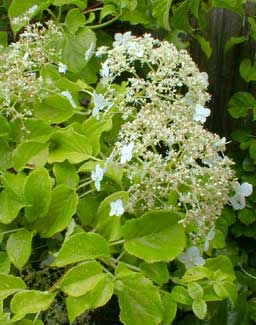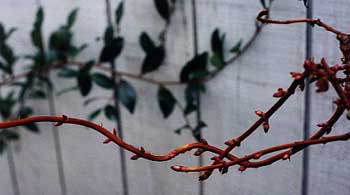
Climbing Hydrangea
slow starters but worthy even when young
"Like a huge Python, winding round & round
The rugged trunk, indented deep with scars,
Up to its very summit near the stars,
A creeper climbs, in whose embraces bound."
-Toru Dutt
(1856‚1877)
(1856‚1877)
The climbing hydrangea (Hydrangea anomala petiolaris) is a subspecies often sold as if "Petiolaris" were a cultivar name. It is native to Japan & Taiwan, introduced to western gardening in 1865. The less often seen version is H. anomala spp anomala is from China. There is also a Korean variant, H. anomala petiolaris var tiliifolia sometimes offered as though it it were a separate species or with cultivar name "Tiliifolia." Perhaps most interesting of all is a new cultivated form which has smaller & strikingly variegated leaves, sold as "Mirranda."
Deciduous climbing hydrangeas prefer moist shady locations in cool to temperate climates, needing considerable protection from the sun in southerly zones. It can be trained as a free-standing shrub or as a groundcover, but it is most often encouraged to be a serious climber. It is ta species with "holdfast" aerial rootlets, & it will happily climb to the top of brick buildings, wooden fences & pergolas, or tall trees.
When obtaining a climbing hydrangea, it saves one hell of a lot of time to get the biggest pot-size. Mere gallon-sized starts will take up to three years to even start climbing well, & a couple more years to bloom.
 Even a good-sized specimen will be slow to establish, because it concentrates its energies on spreading out its roots for the first couple of years. One of ours didn't bloom for the first two years, the other waited until its third year to bloom, but they were at least large enough to cover respectively a large section of a six-foot-tall fence, & a larger section of the garage wall. We also planted a young one-gallon specimen & after four years it still hasn't bloomed.
The blooms are eight inches across, but consisted mainly of the greenish fertile micro-blossoms. The surrounding ruffle of sterile petals are showier but not numerous; occasionally the larger sterile flowers at the periphery of the corymb number a scant one petal each. So these lacecaps or corymbs, though enormous in width, are only moderately showy.
Even a good-sized specimen will be slow to establish, because it concentrates its energies on spreading out its roots for the first couple of years. One of ours didn't bloom for the first two years, the other waited until its third year to bloom, but they were at least large enough to cover respectively a large section of a six-foot-tall fence, & a larger section of the garage wall. We also planted a young one-gallon specimen & after four years it still hasn't bloomed.
The blooms are eight inches across, but consisted mainly of the greenish fertile micro-blossoms. The surrounding ruffle of sterile petals are showier but not numerous; occasionally the larger sterile flowers at the periphery of the corymb number a scant one petal each. So these lacecaps or corymbs, though enormous in width, are only moderately showy.I've seen very old gigantic specimens -- decades old in fact -- which had higher percentages of the larger sterile petals. I do not know if this is the effect of old age, & we can expect ours to behave similarly if we live long enough; or whether the four plants from two sources which we have will always produce a predominance of tiny fertile flowers with a collar of larger petals around the outside edge.
When they're finally well-established & climbing, deciduous hydrangea can become almost aggressive in spread or upward quest, needing often to be trimmed back against a trellis, fence, or wall, lest they bush out into something more akin to oversized wall-shrubs. Plus, these have a likely reach of thirty to forty feet. Eighty feet is not improbable, but that would take a fifty or sixty year wait.
Descriptions of slow-to-establish habits, & racemes predominantly of small unshowy fertile microblooms, should not be constured to mean climbing hydrangea is an insufficient vine for anyone's garden. Even with whatever limitations this may reveal, these are favorite vines of mine. There is no better climber that flourishes in shade in temperate zones. They become increasingly interesting as they age.
Autumn leaf colors vary from plant to plant & each plants growing conditions; the one we have growing on the garage wall in the shade-corridor has the finest autumn yellows, as can be seen in the Autumn Leaves Gallery's Climbing Hydrangea Page.
For the winter garden in particular, there is no deciduous vine that beats them for beauty. Their thick orange to cinnamon-colored exfoliating bark, & the twists & turns of the woody vines, stand out wondrously in the winter. A January branch-photo above is a detail of one of these thick, hairy, orange branches. Comparing this to such excellent spring & summer vines as Clematis, which can be winter eyesoars, the lasting popularity of Climbing Hydrangea is easy to understand.